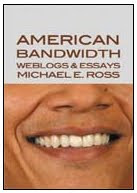.jpg) Longer than I’d have thought possible, the late-night crew has generated brutal laughs at the expense of Tiger Woods. The self-caged Tiger, now said to be staying at home eating cereal, watching cartoons and practicing his golf swing at night, remains behind the curve, the butt of too many jokes. A trip to France has reportedly been considered.
Longer than I’d have thought possible, the late-night crew has generated brutal laughs at the expense of Tiger Woods. The self-caged Tiger, now said to be staying at home eating cereal, watching cartoons and practicing his golf swing at night, remains behind the curve, the butt of too many jokes. A trip to France has reportedly been considered.You can’t help but think of that legendary April 1968 Esquire cover that featured a full-body shot of an in-his-prime Muhammad Ali (the subject of public hatreds of a completely different kind), his body punctured with arrows a la St. Sebastian, patron saint of athletes. But the Tiger debacle has other dimensions. There’s been more than one kind of character assassination going on.
The waitresses union (if there is one) should sue for defamation of character; as the list of Tiger’s conquests has grown, we’ve come to hear their occupations in the service and leisure industries spoken of and written about in sordid, unflattering light.
Robin Givhan of The Washington Post got it right on Sunday: “[T]he way in which jobs such as waitress and model have been tossed about in the Woods story, with a kind of wink and a nod, one would think there is something inherently tawdry about carting pancakes or martinis around on a tray.”
◊ ◊ ◊
One of the underexplored aspects of this rolling tragedy has been the reaction of black Americans, notably black women. For blacks, Tiger’s predicament has generated a barely submerged schadenfreude, a sense of serves-you-right-to-suffer that’s animated by the persistent sense of racial betrayal.
On Dec. 6, the New York Daily News explored the issue in a story that laid bare the hurt, and the willingness within the community to pile on.
On the nationally syndicated Tom Joyner radio show, Woods was the butt of jokes all week.◊ ◊ ◊
"Thankfully, Tiger, you didn't marry a black woman. Because if a sister caught you running around with a bunch of white hoochie-mamas," one parody suggests in song, she would have castrated him.
"The Grinch's Theme Song" didn't stop there: "The question everyone in America wants to ask you is, how many white women does one brother waaant?" …
On the one hand, Ebonie Johnson Cooper doesn't care that Tiger Woods' wife and alleged mistresses are white because Woods is "quote-unquote not really black."
"But at the same time we still see him as a black man with a white woman, and it makes a difference," said Johnson Cooper, a 26-year-old African-American from New York City. "There's just this preservation thing we have among one another. We like to see each other with each other."
Black women have long felt slighted by the tendency of famous black men to pair with white women, and many have a list of current transgressors at the ready.
"We've discussed this for years among black women," said Denene Millner, author of several books on black relationships. "Why is it when they get to this level ... they tend to go directly for the nearest blonde?"
Left unexplored in these ad hominem broadsides is any discussion of the broader social damages of Tiger’s civil transgressions, not just those ostensibly racial ones. The impact of the violation of his marital vows isn’t even discussed; the only unacceptable line Tiger’s crossed in their eyes is a racial one. Curiously, there’s no mention of the signal his marital infidelity sends to generations to young and impressionable Americans across the racial spectrum.
There’s a sense of possessiveness in these comments that suggests Tiger, and by extension all black people, are necessarily bound by the racial tradition of marrying within the race. There’s a dismissal here of Tiger’s civil responsibility as husband and father that’s all the more curious, given black America’s historically proven reverence for the traditions of marriage in general. Where’s the outrage about that?
◊ ◊ ◊
If Tiger is in fact hunkering down with the attorneys and the Cheerios, he's certainly planning how to dampen the trajectory of a scandal achieving a life of its own. But for the rest of us, the Tiger in the wild has been an inviting target. Sometimes too inviting.
For every label you can throw at him, justified and otherwise — philanderer, cheat, womanizer, racial traitor, ethical apostate, self-centered athlete for the ages — there’s another one available. And the willingness or unwillingness to apply it says as much about us as it says about him: the label of human being.
Image credit: Esquire April 1968 cover: Esquire Magazine. Tiger: Public domain.






No comments:
Post a Comment